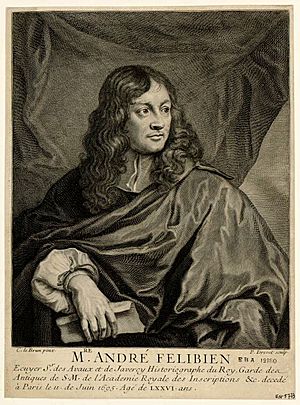André Félibien facts for kids
André Félibien (born May 1619, died June 1695) was a French writer and historian. He wrote about art and was the official historian for King Louis XIV of France. He helped shape how people thought about art in France during his time.
Contents
André Félibien's Life
Félibien was born in a town called Chartres. When he was 14, he moved to Paris to study more. In 1647, he went to Rome as a secretary for an important French ambassador.
Time in Rome
While in Rome, Félibien used his time wisely. He studied ancient buildings and read many books in libraries. He also met famous writers and artists. One of his good friends was the painter Nicolas Poussin. Poussin gave him helpful advice, and Félibien even tried painting himself. Félibien later wrote a book about Poussin's life and work.
Working for the King
When Félibien returned to France, he started writing his famous eight-volume book, Entretiens. He settled in Paris and soon found work with important people like Jean-Baptiste Colbert.
In 1663, he became one of the first members of the Academy of Inscriptions. This was a group of scholars who studied history and ancient texts. Three years later, Colbert helped him become the king's official historian. One of his jobs was to write detailed descriptions of the king's grand parties and events. This helped show the king's power and wealth.
In 1671, Félibien became secretary of the new Académie royale d'architecture. He also gave lectures there. In 1673, he was put in charge of the collection of old objects at the Palais-Royal. His book, Description sommaire (1674), was the official guide to the Palace of Versailles.
Félibien's Writings
Even with all his official duties, Félibien found time to study and write many books. His most famous work is Entretiens sur les vies et sur les ouvrages des plus excellents peintres anciens et modernes. This book was inspired by Giorgio Vasari's Lives of the Artists.
Félibien's Entretiens helped create the field of art criticism. He also wrote Principes de l'architecture, de la sculpture, de la peinture, &c. (1676–1690). His books often promoted French artists. For example, he criticized an Italian artist named Giovanni Bazzi (also known as Il Sodoma). This was partly to make the work of French artist Charles Le Brun seem even better.
Félibien also wrote L'Origine de la peinture (1660). He wrote descriptions of Versailles, La Trappe Abbey, and the art in royal homes. He also edited lectures from the Académie royale de peinture et de sculpture. He translated a book by St. Theresa.
Félibien was highly respected. His motto was "Do well, and tell the truth." He is best remembered for organizing art into a "hierarchy of genres." This was a system that ranked different types of art. He died in Paris in 1695.
Félibien's Family
His son, Jean François Félibien, was also an architect and wrote books about it. Another son, Michel Félibien, was a monk. He wrote an important history of the Abbey of Saint-Denis and a history of Paris.
Art and the Hierarchy of Genres
In 1667, Félibien shared his ideas about the "hierarchy of genres" in art. This was a way of ranking different types of paintings from most important to least important.
He believed that:
- A painter who creates beautiful landscapes is better than one who only paints fruit or flowers.
- Someone who paints living animals is more skilled than those who paint still life (dead things).
- Painting human figures is the most perfect work because humans are God's most perfect creation.
- However, even painting a lifelike portrait is not the highest honor.
- The most respected painters are those who show many figures together. They paint stories from history or myths. This includes showing the good deeds of great people or deep mysteries.
This idea meant that paintings telling a story (like history paintings) were considered the most important. Portraits were next, followed by animal paintings, landscapes, and then still life paintings.
See also
 In Spanish: André Félibien para niños
In Spanish: André Félibien para niños


